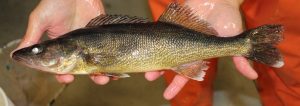Good news for fans of the Friday fish fry: locally raised walleye may soon be coming to a plate near you.
This past spring, the University of Wisconsin–Stevens Point Northern Aquaculture Demonstration Facility (NADF) released the “Walleye Culture Guide,” a manual for fish farmers on how to raise walleye from egg to market-size fish using indoor recirculating aquaculture systems.

The “Walleye Culture Guide” helps fish farmers raise walleye using indoor recirculating aquaculture.
According to lead author and aquaculture outreach specialist Emma Hauser, the guide is the culmination of years of research and a great enthusiasm for the fish, especially in the upper Midwest where it’s enjoyed both as a game fish and one that’s good to eat.
“The facility has been raising walleye for probably the last 15 years now, and there’s been such a strong interest in raising the species indoors for food fish,” she said.
The 65-page guide features findings from Wisconsin Sea Grant-funded research investigating how to raise walleye using indoor tanks for commercial production. Projects explored different starter feeds for walleye, the optimal density of fish per tank, and more recently, how to manipulate light levels and water temperature to ensure they spawn year round.
The process of raising walleye indoors, however, is a tricky one. NADF research program manager and coauthor Tyler Firkus noted that walleye physiology presents a unique challenge.
“When walleye hatch, they’re the size of your eyelash and are very, very delicate,” said Firkus. “It’s really difficult to provide the right conditions for them to thrive and begin accepting a commercial feed, where those issues are easier to overcome with Atlantic salmon or rainbow trout.”
The guide explains the procedures NADF has been refining over the past 15 years to navigate such challenges and features photos and diagrams of protocols, equipment and fish at different life stages. Firkus hopes the visuals make the information more accessible to fish farmers and easier to understand.
“One of the big problems is that a lot of the information that farmers would need to raise walleye is in difficult-to-access or difficult-to-read academic journals,” said Firkus. “And while that’s a great avenue for disseminating this work to the academic community, for the average fish farmer, that’s not the most effective mode of transferring that science.”

A market-sized walleye raised at the UWSP Northern Aquaculture Demonstration Facility. Credit: Emma Hauser
Prospective walleye producers can also consult NADF’s video series, the “Walleye Culture Video Manual,” to learn how to perform the basics of raising walleye indoors, like cleaning tanks and hatching fish. The video series and the guide complement each other: one demonstrates the nuts and bolts of walleye aquaculture, and the other provides the details.
Both the manual and video series are free and available to the public. Said Firkus, “What I hope is that [fish farmers] who are on the edge of deciding what species to raise can decide to go for walleye with a bit more confidence because they have this wonderful guide.”
Walleye continues to be a species with substantial aquaculture potential as a food fish due to well-established markets, high value and fast growth when raised indoors in water reuse systems. Currently, most of the walleye consumed in the Midwest is imported from Canada. With the help of this guide, restaurants across the country could soon feature walleye raised a little closer to home.
Said Hauser, “To be able to raise fresh, locally produced walleye to market is a major benefit not only to consumers but to our local fish farmers.”





